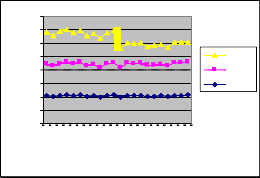
International Journal of Scientific & Engineering Research, Volume 3, Issue 8, August-2012 1
ISSN 2229-5518
Electric energy rating acquired by solar energy in
Albania territory
Anuela Prifti
Abstract— Introduction of the amount of solar radiation and other forms of its appearance, serves directly to the calculation of energy obtained from photovoltaic system (PV). Rating of this energy, includes the monthly average daily production (in kwh Ed+Em), together with the daily average amount of total radiation (kwh/m2) over fixed and 2-axis system. Among the phenomena characteristic of the daily, monthly, seasonal and annual progress of solar radiation and photovoltaic electricity is almost complete bond between them, indicating both the approximate values of the change in their time. From the calculations made to 22 survey stations, indicate that the average daily production of electricity derived from photovoltaic system in the whole country, is 3.5kwh at a fixed plan and 4.6kwh in 2 -axis system.
Key words— electricity, fixed plan, rating, solar radiation, 2-axis tracking system.
—————————— ——————————
rom calculations made for the 22 stations of the survey indicate that the average daily production of electricity derived from photovoltaic system for the whole country is
3.5 kwh at a fixed plan and 4.6 kwh in the system with two
axes [2]. With little changes also presented average monthly production of electricity, which amounts to 107 kwh in fixed plan to 139 kwh in the two axes, so with a value 23% greater of the last one. In the zonal distribution of these values, is observed that larger quantities as always belong to Western Lowland therefore fully in line with the values of these dimensions of solar radiation, such as Durres with 111 kwh, Fier, Tirana, Shkodra and Vlora 109 kwh. Quite characteristic in these values also appear SE part of the Central Highlands province, like Korça, Bilishti and Erseka with 110 kwh, which correlate with the spread of holes and hollow depression faults in this area, representing a significant potential of photovoltaic electricity of our country. In Southern Highlands province, on the contrary, the present values are relatively lower production of electricity obtained from the PV, which reach from 102 kwh in Saranda and Gjirokastra to 103-104 kwh at the center part, including Kukesi and B.Curri with the same values.
————————————————
![]() Anuela Prifti is currently persuing PHD degree program in Polytechnic University of Tirana, Department of Geography. She works at Ministry of Justice, Immovable Property Registration Central Office,
Anuela Prifti is currently persuing PHD degree program in Polytechnic University of Tirana, Department of Geography. She works at Ministry of Justice, Immovable Property Registration Central Office,
Department of Cartography & First Registration, Tirana, Albania. E-mail: ela_prifti@hotmail.com
In larger amounts is presented average monthly production of electricity from this system (PV) in a sliding plan with two axes, which stands for a regional expansion plan as to the fixed, reaching 139 kwh or 23% more large, which naturally belong to 149 kwh Durres, Fier, Tirana, Shkodra and 147 kwh, then ranked the Bilisht
Korca Erseka 141 kwh and 145 kwh. Whereas relatively lower amounts in Saranda and Gjirokastra meet with 130
kwh, 126 kwh Berat, Permet 133 kwh, adding northeast of Bajram Curri and Kukes 127 kwh and 130 kwh. In monthly distribution of electricity (Em) is observed smaller values, about 50 kwh in December in a fixed plan, and about 60 kwh in 2-axes, ie about 17% less, while biggest values meet this month in Shkodra, Tirana, Lushnje, Durres, Fier, Vlora, etc, for both plans. But a month with the greatest value of Em, also for both plans (the fixed and movable), meet in July hich belong to 154 kwh in fixed plan and 205 kwh for the system with two axes, whereas the highest values of this month both systems belong to the same observation point above. In the context of assessment of electricity derived from photovoltaic system, along with average daily production, also is presented average daily amount of global radiation per m2, derived from the same system modules. From the data points above the survey, indicate that the average daily amount of global radiation (Hd) for the whole country was 4.6 kwh/m² over a stationary plan. It is worth mentioning that changes of the values of this indicator is almost negligible among all points of observation, by 0.6-0.8 kwh/m² among hich separate Western Lowlands holes and hollow depressed faults worth 4.6-4.9 kwh/m² and in the hill country of southern and northern NE here the amount of this radiation reaches
IJSER © 2012
International Journal of Scientific & Engineering Research, Volume 3, Issue 8, August-2012 2

ISSN 2229-5518
4-4.4 kwh/m². Whereas in a movable plan with two axes these values reach up to 6 kwh/m², so about 25% larger
than a fixed plan. It is understood that the average daily amount of this radiation has a regional distribution similar to those of the monthly average daily production of electricity from the PV, that reaches the greatest values of
6.2-6.9 kwh/m2 during the depression fault, SE West and
part of the province. The Central Highlands were characterized by a small change to the values 5.5-5.9 kwh/m2 in Southern and Northern province of the Central NE. Quite characteristic also is shown the average amount of global radiation per m2 (Hm), which appears to change the plan expressed between a fixed and removable one with two axes, reaching about 25% more in the last one. During a stationary plan the average amount of global radiation in the country amounts to 142 kwh/m², posing less difference between all points of observation, (22 points), particularly those in Western Lowland and SE area of Central Highlands province. In the first zone is distinguished Durres with 148 kwh/m², Vlora and Fieri with 147 kwh/m², Shkodra and Tirana with 146 kwh/m², while in Korça distinguishes SE, Bilisht with 145 kwh/m², Pogradec with 143 kwh/m etc. Relatively small amounts of global radiation belong to the Southern Highlands province Permet, Gjirokastra and Saranda with 137 kwh/m². Then rankes B.Curri, Kukes in the NE of the country to 135 kwh/m² excluding Basin of Mati and Black Drin valley values in Burreli 145 kwh/m², Peshkopia and Kruja 142 kwh/m². The average amount of global radiation is presented with changes expressed during a movable plan in two axes, which has a value of 189 kwh/m², as approximately 25% greater than in the stationary plan, characterized also by almost the same spatial values distribution of this one. The second area for the values of the radiation holes and hollow depression faults are in SE central hill country, such as Korça and Bilisht with 191 kwh/m², Erseka and Pogradec with 187 kwh/m², while the northern part of the NE of this Burrel highlight region with
193 kwh/m², Peshkopia with 186 kwh/m², Elbasan with 189
kwh/m², Kruja with 179 kwh/m² etc. The relatively smaller average global radiation belongs to the Southern Highlands province as Saranda and Gjirokastra to 175 kwh/m², Permeti 178 kwh/m², Berat 171 kwh/m² etc., including both the northern part of the country in B.Curri 167 kwh/m², Kukes 172 kwh/m² etc. At the annual distribution of the average amount of global radiation, as to hat the average monthly production of electricity, are observed differences expressed between a fixed plan and the sliding two axes. Thus the average value of global
radiation (Hm) in a stationary plan is 1710 kwh/m², so 25%
greater than the average monthly production of
photovoltaic electric power system (1285 kwh). By contrast ratio appears the average value of global radiation (Hm) to a fixed plan with average monthly production of photovoltaic electric power system (Em) to a mobile plan, which have an almost negligible change about 2% to account sight. In these conditions the value of Hm in the annual amount fixed plan is 1710 kwh/m², whereas the movable Em is scheduled to 1670 kwh. Obviously characteristic are marked differences in values of Hm fixed plan with it during a mobile plan, which reach respectively
1710 kwh/m² and 2229 kwh/m² in the whole country, so about 25% more for the latter. However it is important to note that the annual average daily production of electricity (Em) at a fixed plan amounts to 1285 kwh nationwide, but is characterized by significant changes between the provinces of our country. Among them stands out the Western Lowlands in Shkodra, Tirana, Vlora and Kuçova 1310 kwh,
1330 kwh Durres etc. Then rankes the Bilishti, Korca 1320 kwh, 1310 kwh Erseka, Pogradeci 1300 kwh, which lie in SE central hill country. whereas relatively smaller values in the southern hill country meet Gjirokastra, Saranda and Berat 1230 kwh, 1250 kwh Permet, including the northern area of this region as NE B.Curri 1250 kwh, Kukes 1240 kwh and Peshkopia 1290 kwh.
Daily/monthly average of electricity production due to PV
![]()
system in kwh (fix/2 axes plan)
Station Hd Hm Hd Hm
![]()
Berat 4.54 138 5.62 171
1660 2050
![]()
Burrel 4.78 145 6.36 193
1740 2320
![]()
Durres 4.88 148 6.57 200
1780 2400
![]()
Elbasan 4.71 143 6.21 189
1720 2270
![]()
Fier 4.83 147 6.5 198
1760 2370
![]()
Gjirok. 4.51 137 5.74 175
1650 2100
![]()
Krujë 4.66 142 5.88 179
1700 2150
![]()
Kuçovë 4.72 144 6.23 189
1720 2270
![]()
Kukës 4.43 135 5.64 172
1620 2060
IJSER © 2012 http://www.ijser.org
International Journal of Scientific & Engineering Research, Volume 3, Issue 8, August-2012 3
ISSN 2229-5518
![]()
Lezhë 4.71 143 6.16 187
1720 2250
![]()
Lushnje 4.83 147 6.46 197
1760 2360
![]()
B.Curri 4.45 136 5.48 167
1630 2000
![]()
Bilishti 4.77 145 6.31 192
1740 2300
![]()
Ersekë 4.72 144 6.14 187
1720 2240
![]()
Korçë 4.76 145 6.27 191
1740 2290
![]()
Përmet 4.56 139 5.86 178
1670 2140
![]()
Peshkopi 4.66 142 6.11 186
1700 2230
![]()
Pogradec 4.69 143 6.09 185
1710 2220
![]()
Sarandë 4.5 137 5.74 175
1640 2090
![]()
Shkodër 4.81 146 6.45 196
1760 2350
![]()
Tiranë 4.82 146 6.41 195
1760 2340
![]()
Vlorë 4.82 147 6.48 197
1760 2360
![]()

Table 1
With such changes also occurs zonal extent of the annual global radiation on a fixed plan, which also stands to the Western Lowlands Shkodra, Tirana, Fier and Vlora to 1760 kwh/m², Durres 1780 kwh/m², Lushnja, Lezha of Kuçova
1720 kwh/m² etc., followed by SE depression fault holes and hollow as the Bilishti, Korça 1740 kwh/m², Erseka, and Pogradeci 1720 kwh/m² etc. During a stationary plan, the average amount of global radiation in the country amounts to 142 kwh/m², posing less pronounced differences between all points of observation, (22 points), particularly those in Western Lowland and SE area of Central Highlands province. In the first zone is distinguished Durres with 148 kwh/m², Vlora and Fieri with 147 kwh/m², Shkodra and Tirana with 146 kwh/m², while in Korca distinguishes SE, Bilishti with 145 kwh/m², Pogradeci with
143 kwh/m etc. Relatively small amounts of global
radiation belong to the Southern Highlands provinces of
Permeti, Gjirokas-tra and Saranda with 137 kwh/m². Then, ranks B.Curri, Kukesi in the east of the country. The
average amount of global radiation is presented with changes expressed during a mobile plan in two axes, which has a value of 189 kwh/m², so approximately 25% greater than in the stationary plan, characterized also by a distribution almost the same spatial values of the this one. Thus larger values of global radiation belong to Durres average 200 kwh/m², Shkodra and Tirana 196 kwh/m², Vlora 197 kwh/m², Lushnja and Kuçova 189 kwh/m², Fier 198 kwh/m² etc., which lie in the western plains. The second area for the values of the radiation holes and depression fault hollows [1] listed in SE central hill country, such as Korça and Bilisht with 191 kwh/m², Erseka and Pogradec with 187 kwh/m², while the northern part and NE of this Burrel highlight region with 193 kwh/m², Peshkopia with 186 kwh/m², Elbasan with 189 kwh/m², Kruja with 179 kwh/m² etc.
![]()
Daily/monthly average global radiation due to PV system in kwh/m2 (fix/2 axes plan)
Station Hd Hm Hd Hm
![]()
Berat 4.54 138 5.62 171
1660 2050
![]()
Burrel 4.78 145 6.36 193
1740 2320
![]()
Durres 4.88 148 6.57 200
1780 2400
![]()
Elbasan 4.71 143 6.21 189
1720 2270
![]()
Fier 4.83 147 6.5 198
1760 2370
![]()
Gjirok. 4.51 137 5.74 175
1650 2100
![]()
Krujë 4.66 142 5.88 179
1700 2150
![]()
Kuçovë 4.72 144 6.23 189
1720 2270
![]()
Kukës 4.43 135 5.64 172
1620 2060
![]()
Lezhë 4.71 143 6.16 187
1720 2250
![]()
Lushnje 4.83 147 6.46 197
1760 2360
![]()
B.Curri 4.45 136 5.48 167
1630 2000
![]()
Bilishti 4.77 145 6.31 192
1740 2300
![]()
Ersekë 4.72 144 6.14 187
1720 2240
![]()
Korçë 4.76 145 6.27 191
1740 2290
IJSER © 2012 http://www.ijser.org
International Journal of Scientific & Engineering Research, Volume 3, Issue 8, August-2012 4
ISSN 2229-5518
![]()
Përmet 4.56 139 5.86 178
1670 2140
![]()
Peshkopi 4.66 142 6.11 186
1700 2230
![]()
Pogradec 4.69 143 6.09 185
1710 2220
![]()
Sarandë 4.5 137 5.74 175
1640 2090
![]()
Shkodër 4.81 146 6.45 196
1760 2350
![]()
Tiranë 4.82 146 6.41 195
1760 2340
![]()
Vlorë 4.82 147 6.48 197
1760 2360
![]()

Table 2
The relatively smaller average global radiation belongs to the Southern Highlands province as Saranda and Gjirokastra to 175 kwh/m², Permeti 178 kwh/m², Berati 171 kwh/m² etc., including both the northern part of the country, in NE B.Curri 167 kwh/m², Kukes 172 kwh/m² etc. At the annual distribution of the average amount of global radiation, as to the average monthly production of electricity, are observed differences expressed between a fixed plan and two axes plan. Thus, the average value of global radiation (Hm) in a stationary plan is 1710 kwh/m², so 25% greater than the average monthly production of photovoltaic electric power system (1285 kwh). By contrast ratio appears the average value of global radiation (Hm) between a fixed plan with average monthly production of photovoltaic electric power system (Em) to a movable plan, ho have an almost negligible change about 2% to account sight. In these conditions the value of Hm in the annual amount fixed plan is 1710 kwh/m², whereas the mobile Em is scheduled to 1670 kwh. Obviously characteristic is marked the difference in the values of Hm fixed plan with him during a movable plan, which reach respectively 1710 kwh/m² and 2229 kwh/m² in the whole country, so about 25% more in the last one. However it is important to note that the annual average daily production of electricity (Em) at a fixed plan amounts to 1285 kwh nationwide, but is characterized by significant changes between the provinces of our country. Among them stands out as the Western Lowlands in Shkodra, Tirana, Vlora and Kuçova 1310 kwh, 1330 kwh Durres etc., Then rank the Bilishti Korca 1320 kwh, 1310 kwh Erseka, Pogradec 1300 kwh, which lie in SE central hill country. Whereas
relatively smaller values meet in the southern hill country as Gjirokastra, Saranda and Berat 1230 kwh, 1250 kwh Permet, including the northern area of this region as NE B.Curri 1250 kwh, Kukes 1240 kwh and Peshkopia 1290 kwh. With such changes also occures zonal extent of the annual global radiation on a fixed plan, which also stands in the Western Lowlands Shkodra, Tirana, Fier and NE to
1760 kwh/m², Durres 1780 kwh/m², Lushnja, Lezha and Kuçova 1720 kwh/m² etc., followed by SE depression fault holes and hollows as the Bilishti, Korca 1740 kwh/m², Erseka and Pogradeci 1720 kwh/m².

In the framework of rating of solar electricity generation in PV, very significant represents, long calculation of the monthly average radiation on the horizontal plane (Hh), the optimal slope (Hopt) and H (90°) of this plan. From data analysis of 22 stations above-mentioned, we note that greater quantities of monthly average radiation are achieved in plans with optimal inclination 30o-35o, particularly during the period April to September, which is generally about twice of that from October to March. Nationwide radiation values, reaches in optimal descent plan 3000-3500 wh/m2 during the period from October to March, while in the April-September in most of the country is over 6000 wh/m², particularly in Western Lowland. Naturally, larger values during the first period extended to 3517 wh/ m² in Lushnje and Durres, Shkodra 3477 wh/m², Tirana 3453 wh/m², Fier 3348 wh/m², Erseka 3227 wh/m². Relatively, small amount of this radiation belong to the Southern Highlands province in Gjirokastra 2902 wh/m², Sarande
3057 wh/m², Permet 3102 wh/m², then ranks the Eastern, NE area of the country, such as Kukes 1915 wh/m², B.Curri
2338 wh/m² and Peshkopia 2345 wh/m². During the second
period, distribution of these values is presented almost the same in the period from October to March, in Durres 6223 wh/m², in Vlora, Lushnja, Tirana 7068 wh/m², Fier 6193 wh/m², Shkodra 6137 wh/m², and SE hollow holes with very small changes. This phenomenon of solar radiation values is expressed in Korca 6158 wh/m², Bilisht 6128 h/m², Erseka 6102 wh/m², after hich rank South hill in Saranda
5850 wh/m², Permet 4933 wh/m², Elbasan 5201 h/m, etc., associated in almost value, close to Kukes 5297 wh/m², B.Curri 5272 wh/m² in the northern area of the country. Obviously, more long-term average values of the larger radiation there’s in July month. In the Western Lowland reaches over 6600 wh/m², particularly in Fier 6670 wh/m², Tirana 6660 wh/m², Shkodra 6680 wh/m², Vlora
6710 wh/m², Durres and Lushnje 6680 wh/m². Also is
IJSER © 2012 http://www.ijser.org
International Journal of Scientific & Engineering Research, Volume 3, Issue 8, August-2012 5
ISSN 2229-5518
noticed that such approximate value meet in the hollow cavities as in SE of Korça 6610 wh/m², Bilishti 6580 wh/m²,
Erseka 6600 wh/m², Pogradec 6560 wh/m², while to Kukes
6210 wh/m² and to B.Curri 6180 wh/m² in the NE and East
of the country take relatively less amount of this
radiation. Associated with smaller values of the average monthly radiation, is December, which constitutes 40-45% of annual average amount and 22-30% less than January hich ranks immediately after December. In difference from July, December has the most significant changes to January in the SE holes and hollows, as in Korca 35%, 36% Bilishti, Erseka 32%, then rank South hill in Saranda 28%, 30% Gjirokastra, Permet 32 %, whereas in the northern area of the NE of the country these changes arrive in Kukes, 28%, Peshkopia 30% and B.Curri 34%. Larger values of July meet as usual in Western Lowland, in hich are represented from 45 to 54% of the annual average, in holes and hollows
39-40%, whereas in Kukes and Peshkopia 42%. Greater amount of radiation during the December monthly average has Shkodra 2310 wh/m², Fier and Vlora 2200 h/m², Tirana
2150 h/m2, while smaller values belong to the Southern
Highlands province, like in Gjirokastra 1780 wh/m²,
Permeti 1760 wh/m², Sarande 1890 wh/m2, reflecting the role of its mountain ridges. Of course the biggest changes of average amounts of radiation on the horizontal plane belong to the middle of the transitional seasons of spring and autumn, so those between September, October, March and April reach respectively 27% and 32% for the account of April and September. Values greater than those of September-October has Tirana and Shkodra 1620 wh/m2, Durres 1580 wh/m², Fier 1540 wh/m², Lushnja 1500 wh/m² in Western Lowland. hile in the SE hollow cavities, in NE east of the country, also meet the related values such as Korca 1650 h/m², Bilishti 1620 wh/m², Erseka 1530 wh/m², Peshkopia 1670 wh/m² and Kukes 1530 wh/m². The zonal distribution have also almost the same difference as in April to March, which arrives in Fier 1420 wh/m², Tirana and Shkodra 1360 wh/m², Vlora, Durres, Lushnje 1390 wh/m2 more than in October. Appears rather peculiar the fact that the SE holes and hollows obtain approximate quantities, such as Korça and Bilisht 1420 wh/m², Erseka
1380 wh/m², with wide field of relief, including both
Permeti 1450 h/m², Gjirokastra 1390 wh/m² in the Southern Highlands province. The difference between the months of transitional seasons prove that in September the monthly average is 11% and it takes more long-term average radiation that April, which are related to the transition from extreme seasons, respectively so that the summer and winter. Regarding the two other plans, so he optimal slope
and H (90°), we emphasize that these changes appear very irregular and much smaller size, especially the second
plan, which takes an average of 10 April % long-term monthly irradiation over October, respectively 601 wh/m² and 540 wh/m². But the average monthly radiation values in plan with optimal slope are relatively large, so in September takes on average 22% more than October, respectively 1237 wh/m² and 962 wh/m². Naturally, larger values in both plans in April meet in Fier 1020 wh/m², Gjirokastra 1120 wh/m² (Hopt) and 1050 wh/m² (90°), Lushnje 1190 wh/m² on two levels, whereas in 90° plan Tirana, Shkodra, Korca, Permeti with larger values in March. September, in contrast to April, is noted for great value in both plans, especially the optimal sloping average amount of radiation that reaches to 1237 wh/m², while the biggest is in Tirana and Shkodra with 1350 wh/m2, Lezha
1580 wh/m², Krujë 1600 wh/m², Elbasan 1400 wh/m² in the
Western Lowland. With few changes appear holes and hollows in SE of Korça 1420 wh/m2, Pogradec 1480 wh/m², Bilisht 1370 wh/m², Erseka 1300 wh/m2, followed by Kukesi
1330 wh/m², Peshkopia 1490 wh/m² and B.Curri 1270
wh/m² in eastern areas. With characteristic features also
appear monthly average amounts of radiation on the horizontal plane (HH) and 90°, which appear to be expressed between the period from October to March and from April to September. Thus long-term monthly average values greater cover the period from October to March in the plan with slope H (90°), which comprise from 22%-30% more than those in the horizontal plane. Distinguishes in particular Durres, Fier, Lushnja with the value of H (90°) respectively 3517 wh/m², 3448 wh/m², 3448 wh/m2, while those in the horizontal plane 2450 wh/m², 2449 wh/m² and
2457 wh/m². Regarding the period April to September emphasize that the values of the radiation on the horizontal plane are 43%-49% larger than those in the slope H (90°), excluding Kukes, Lushnje and Durres with very little difference between the two plans (4%) for the account of H (90°). These marked differences are expressed very well in the annual average of these values, here the largest amount is received in the horizontal plane, with 25 %-31% more than those at 90° plan, excluding Gjirokastra, Kukes, Durres, Fier and Lushnje with 12% in slope H (90°). Greater values in long-term annual radiation on the horizontal plane meet in Fier 4280 wh/m², Tirana 4220 wh/m², Shkodra 4180 wh/m², 4290 South h/m² in the Western Lowland, then rank Korça and Bilisht 4230 wh/m², Erseka 4210 wh/m², Pogradeci 4150 wh/m2 in SE holes and hollows. With significant changes occure this radiation quantities in Durres, Lushnje, Fier and Kukes,
IJSER © 2012 http://www.ijser.org
International Journal of Scientific & Engineering Research, Volume 3, Issue 8, August-2012 6
ISSN 2229-5518
here larger values belong to H (90°), plans hich are 12%
larger than those in the horizontal plane, being expressed
in real values respectively by 4830 wh/m² and 4830 wh/m² (Kukes). A characteristic distribution of this seasonal radiation is also presented in the above three plans, with concrete in very different values between seasons. One of the special features of this distribution is the long-term average monthly amount for most of the country. The most value from 14 to 17% of the radiation in the plan H (90°) have autumn, spring, summer and winter months and the seasons, excluding Fier, Durres, Lushnje, Gjirokastra and Kukes, and larger values in summer season and spring. Under these conditions, long-term average monthly amounts of radiation during the summer months to plan H (90°) are in the majority of our country (10 observation points) 55-57% smaller than those in the horizontal plane and optimal sloping, respectively by 2800 wh/m² to
6500wh/m². In winter, the average is 2540 wh/m2 in plan H (90°), which means about 12% more with much smaller changes than those with two other plans in the same season. Season of spring and autumn in the H (90°) take the biggest amount of radiation. It represents a very different state compared to values in horizontal and optimal inclination. In most of our country the amount of radiation observed in plan H (90°) during the fall is 6-9% more than in the horizontal plane of this season, rather it is
21% smaller than values of radiation in optimal plan
during this season. By analysis of the data is expressed quite well the fact that in the H (90°) amounts of radiation during the winter and the autumn are respectively 26% and 11% larger than those in the horizontal plane, while in spring rather quantities of radiation on the horizontal plane are in the majority of our country 30% larger than those in plans H(90°). We note that the smaller amount of the monthly average radiation is characteristic for the winter months on the horizontal plane (HH), which arrives to an average for the whole country 1833 wh/m², then rankes 90° plans with 2781 wh/m2, so 35% more. One of the special features of the 90° plan amount of radiation is the fact that the values of the winter months have a very small
difference (3%), which states in relevant quantities 2781 wh/m² and 2871 wh/m². These differences between the two
seasons associated with the apparent movement of the sun, which in its southernmost position during the winter gives value of 90° plan, and northward displacement in summer and large angle of solar rays fall on the contrary, gives value horizontal plan [4]. This planetary phenomenon directly expresses in the fact that larger quantities of long- term monthly average radiation are obtained in a horizontal plane in the summer months with an average annual value of 6558 wh/m², so about 8% more than in plan with optimal slope (6018 wh/m²), which ranks just behind him. However, note that with the exception of Tirana and Vlora, the rest of the points of observation of monthly average values of radiation we meet on the other seasons (spring, autumn and winter) are larger in plan with optimal slope (25-33% larger). There’s a significant reduction in average monthly amounts of radiation on the horizontal plane between the months of autumn and winter, with a latter amounting to 1833 wh/m2, so about
45% less (3327 wh/m²). From the data of average monthly
amounts for all seasons is noted that larger values of
radiation are obtained in the optimal plan sloping, excluding summer, which is presented with significant changes to those plans, particularly H (90°). During the summer the amount of radiation in the optimal slope is
57% greater (6018 wh/m2) than in plans 90° (2583 wh/m²)
spring 28%, in fall 15%, while that of winter only 3%. These data indicate that changes in radiation values between these two plans decreased from spring to winter, but from the amount of solar radiation on the horizontal plane given, on the contrary, the changes increased significantly from 18% to 29% during the spring and fall months, to 32% among those of winter related to the plan with optimal slope. Unlike long-term monthly average quantities appeared between the values of radiation on the horizontal plane over the H (90°), among them the difference between Long-term monthly average rating in horizontal, optimal inclination and 90o plan (W/m2)
IJSER © 2012 http://www.ijser.org
International Journal of Scientific & Engineering Research, Volume 3, Issue 8, August-2012 7
ISSN 2229-5518

Table 3
16000
14000
12000
10000
8000
6000
4000
2000
0
Graph 3
H(90) Hopt Hh
winter, difference between them reaches 30%, so 2608 wh/m2 (H90°) and 1833 wh/m² (HH).These seasonal
changes in long-term monthly average values of radiation between these plans, as noted above, indicate the apparent displacement of the sun, to the formation of both seasons. In summer radiation at 90° plan, also highlights the high value in five observation points such as Fier 6603 wh/m2, Durres 6597 wh/m², Lushnja 6600 wh/m², Gjirokastra 6250 wh/m² and Kukes 6057 wh/m², while the other gets 16 points on average 2583 wh/m2, about 60% less. Amidst these observation points also meet larger quantities of radiation in this plan during the spring months, so Fieri 5360 wh/m2, Durres 5383 wh/m², Lushnja
5347 wh/m² and Gjirokastra 5040 wh/m², together with
the respectively fall 4540 wh/m², 4653 wh/m², 4550 wh/m²
and 4207 wh/m², so on average 15% less. Whereas in most of our country during the monthly average quantities H (90°) plan are larger in the autumn season than in the spring, even about 12% larger than those obtained in the horizontal plane, respectively 3750 wh/m² and 3315 wh/m². Quite characteristic also shows that long-term monthly average amount of radiation during different seasons, the greatest value was obtained in those plans with optimal slope (273527 wh/m2), which represents about
2% more than in achieved plans 90° (267240 wh/m²) and
12% more of it in the horizontal plane. Comparing with the
values of the radiation on the horizontal plane (4154
wh/m²), are 8% larger than those in plans H (90°) (3839 wh/m²), and occupies first place in the values obtained with optimal slope plan (Hopt) (4681 wh/m²), which are respectively 11% and 18% higher than 2-axis plans. Seasonal values of average monthly radiation are also distinguished for zoning changes in the above three plans that are expressed significantly in amounts of this radiation, particularly in SE Western Lowland holes and hollows and partly in Southern Highlands province. Thus, larger quantities of radiation long-term monthly average summer belong to the horizontal plane, as Vlora 6783 wh/m², Fier 6670 wh/m², Shkodra 6553 wh/m2, Durres 6780
them highly expressed appear during the summer. Thus the amount of radiation in the horizontal plane with a monthly average 6558 wh/m2 is 41% greater than the slope at 90°, so average 2583 wh/m². But during the spring season, this difference amounts to 18% greater in the horizontal plane (HH) in values 5421 wh/m² respectively and 3723 wh/m². This report promptly reversed during the autumn season on behalf of the 90o plan with a significant percentage (11%) and in real value 3315 h/m2 in the horizontal plane and 3750 wh/m2 in the H (90°), while in
wh/m², Tirana 6680 wh/m², Lushnja 6747 wh/m². With less changes appear Korca 6673 h/m², Bilisht 6660 wh/m², Erseka 6633 wh/m² and Pogradec 6563 wh/m2. Such a distribution in these regions also show the amount of radiation in the optimal plan, while in those with inclination 90°, on the contrary, the values are distinguished by significant differences between Fier, Durres, Lushnja, Gjirokastra B.Curri with radiation quantities 6421 wh/m2 to all other points of observation with an average value 2870 wh/m2, so 55% less. In a change
IJSER © 2012 http://www.ijser.org
International Journal of Scientific & Engineering Research, Volume 3, Issue 8, August-2012 8
ISSN 2229-5518
from the summer, almost all the average monthly amounts of radiation during other seasons, especially spring and
autumn are distinguished by a relatively regular distribution of values in the three plans listed above. However note that the survey points in the Western Lowland radiation received on average a 5-7% amount more than most of the country, particularly in plan H (90°) during the spring season, which reached about 42% more. During the winter, prevails immediately smaller amount of radiation in the horizontal plane with an average value for the whole country 1803 wh/m², in Southern mountain regions separates by 2% less (1777 wh/m²), reflecting inconsiderable changes and the regular distribution on the two other plans during the year. With characteristic features also presents approximate values between the amounts of radiation in the horizontal plane in spring with the optimal plan (Hopt) in autumn, which have a difference of about 3% on behalf of HH, respectively,
4521 wh/m² and 4378 wh/m2, reflecting the importance of
this plan during the spring season. Such a similarity values of radiation is presented in the plan H (90°) during the summer with them in winter Hopt, among it gains 4% more radiation, respectively 2583 wh/m² and 2691 wh/m². Another phenomenon on characteristic seasonal distribution of long-term monthly average radiation is also the approximate value of this H (90°) plan radiation between fall to spring, so respectively 3723 wh/m² and
3790 wh/m², with the horizontal plan (Hh) with a difference between them respectively 2%, 11% and 3% [3].
In the Albanian territory, average daily rating of electricity, produced from photovoltaic systems, is 3.5 kwh. This value amounts from 107 kwh in fixed plans to 139 kwh in 2- axes plans, with a value 23% greater in the last one. The month, with the greatest Em value, in fix and 2-axis plan, belong to July, respectively, 154kwh in fixed plans, 205kwh in the 2-axis plan. There are observed smaller values, in monthly distribution of electricity (Em), which belong to December, respectively 50 kwh in fixed plans and 60 kwh in the 2-axis plans That means 17% less for the last one.
[1] Geology of Albania, 1998.
[2] Measurements of Energy, Environment
& Water Institute, Meteorological Stations, 2008-2010. [3] PVGIS Classic Programme.
[4] Zorba. P., Climatology - AlbPaper
Edition, Tirana 2009.
IJSER © 2012 http://www.ijser.org